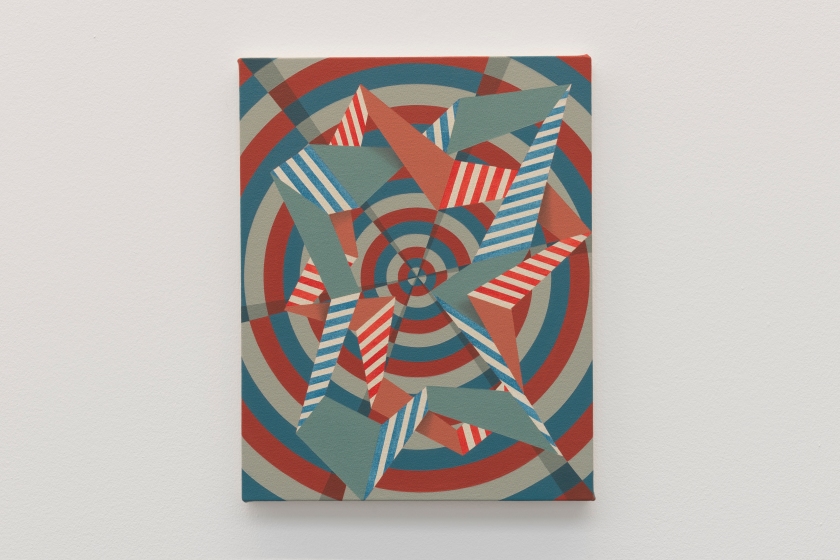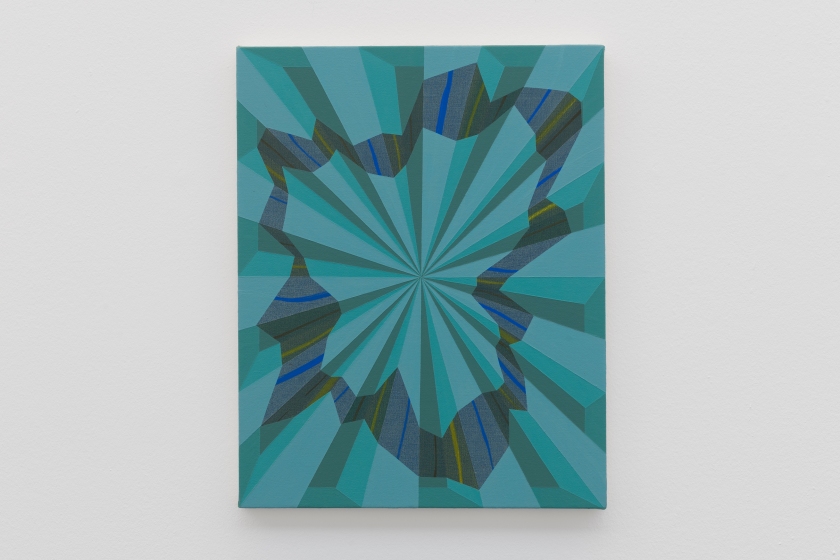Tomma Abts at Serpentine Sackler Gallery
7 June to 9 September 2018

After winning the Turner Prize in 2006 and providing the stand-out work in ‘Painting Now: five contemporary artists’ at Tate Britain in 2013-14, it has been interesting to see a presentation of Tomma Abts’ paintings from 2002-2018. The current exhibition at Serpentine Sackler Gallery has attracted ample media coverage and Adrian Searle, writing for the Guardian, has waxed lyrical in his four star review: ‘Like fans in the hands of animated Andalucíans’. Fellow Guardian critic, Laura Cumming, goes one better and gives the show five stars. Neither critic labels the work ‘abstract’ – although Cumming introduces the term with a denial of sorts when she concludes that, “…with metaphor comes a kind of lyrical philosophy, to the effect that no painting seen or made by human beings can ever be wholly abstract.”
But are these abstract paintings? They might appear to be so at first glance. But what category of the abstract are we viewing? Hard edge, geometric shapes of planar colour-forms, distinctively characterised by purposely limited but expertly rendered colour palettes abound that could have antecedents from Kandinsky to Bridget Riley. But there are perspectival, trompe-l’œil elements too. Not only indicated by folded forms and shadows cast by ostensibly unidentifiable abstract structures, but figure/ground relationships create definite illusions of spatiality. A sense of voids into which the viewer might be able to place a hand between forms, or know that there are extensions to these constructs occluded by other structures and facades, suggests the still-life genre. If these are figurative images, we are perhaps looking at forms we have not seen before – or at least not noticed in our immediate environment.
The subject matter of Abts’ paintings may not be obvious and whether we read or understand these enigmatic images as figurative or abstract is clearly open to interpretation. Reading available literature appears necessary and is understandable. Explanation and elucidation helps to unlock barriers to understanding apparently abstract, non-figurative works – even if a counter-argument to trust one’s own eyes and personal interpretation is tempting. Ideally, one should visit the exhibition and buy the amply illustrated catalogue or download the press pack that includes an essay by art-historian Kate Nesin. Alternatively, pick up a bargain priced copy of the exhibition booklet for a pound. Lizzie Carey-Thomas’ informative introduction sets the scene perfectly. With a little history and quotations from the artist she describes the practicalities of Abts’ production lucidly and adds a curator’s note that the artist had full control over selection and arrangement of the works for the show. By now you could also have read Luke Elwes’ recent Instantloveland article, ‘How to write about Tomma Abts?’ Accounting for many and various interpretations and explanations of Abt’s paintings, the article’s diverse references will set the reader off on a journey that will expand how the viewer might choose to frame the works. Elwes’ final sentence, “Their origins are obscure, and their forms are strange: such is the lure of the uncanny”, had me considering that fascinating term at the end. The ‘uncanny’ could well be applied to Abts’ imagery whether we see the works as abstract or not. There is a familiarity about the forms and configurations, although anything unsettling is subtle and notions of the abject might be a step too far. Maybe there’s a quirky Kafkaesquesense of never quite arriving at a final interpretation – but minus any surreal horror or underlying commentary on institutionalised society. Although an anonymous atmosphere in the work sneakily underlies the initially pleasantly colourful and pristine imagery. Emotions are checked by a tightly controlled application of paint.
On my initial arrival (I returned later for the curator’s talk), an unexpected source of commentary was gleaned from listening to a language teacher who was taking a small group of her students around the show. Her lesson plan was clearly geared towards terminology, and considering these canvases as abstract paintings enabled a focus on formal and descriptive terms that may have been complicated by overtly figurative works. Defining visual forms and its specific multi-lingual language from the written and spoken word made for a fascinating discourse that the students handled really well. All forms of language make connections and create communities, for language is ultimately social in its constructive and relational purpose.

“If you can define it, it’s not abstract…. Your minds are set for classical art… What’s the story?” Looking at ‘Schwiddo’ (2018) the tutor-cum-guide referenced associations that a viewer might already have. Chopsticks and two bowls were suggested, as the participants had shared a meal earlier. (Or was it a record player, raffia mats – or an aerial view of mown grass?) I wondered – is painting a class of fiction? But whatever the implied narrative, or the opinions of others, the viewer is obliged to use their eyes too – for this is an absolutely visual body of work that reminded me of Patrick Heron’s maxim when he explained that, “Colour is both the subject and the means; the form and the content; the image and the meaning, in my paintings today.” Invoking Heron, who made quick decisions for his imagery after long hours of premeditation, followed by purist exactitude in application and adroit decision-making, could be a long shot. But equally, colour is inseparable from Abts’ forms, albeit with tonal rendering that Heron would have rejected.
I also recalled the work of Helene Appel and Peter Dreher. They are not to be categorised as ‘colourists’ (and the Germanic connection is superficial), but the ability to apply paint with craft-like precision over extended periods of time, and to be able to modulate colour without resorting to brashness or garishness are cohesive factors in their disparate practices. We might also wonder about the personality of the maker of these paintings because they are obviously handmade and cannot be confused with the printed or the digital. Quietly meditative, with virtues of patience and determination to complete tasks expertly, might befit all of these painters.
At the Serpentine the curation is simple and Abts has resisted the temptation to fill every available square metre with a canvas. (She even left some drawings out that were originally to be included.) Abts’ expert ‘eye’ for spatial distribution and visual calibration is subtly manifested in the slightly different measurements of intervals (about 2 to 3 metres) between each painting and might be as important as the sub-divisions of space within the various compositions. Add the illusionism of overlaps, curves and shadows to the tastefully coloured Euclidian, architectonic still-life-type spacescapes and the scope for a non-organic visual aesthetics opens up endless, exponential possibilities.

The work is not arranged chronologically but visitors were mostly starting at work no.1 – ‘Oeje’ (2016) – and finishing 25 canvases later at ‘II’ (2018), circumscribing the empty central gunpowder storerooms in a clock-wise journey of stops and starts. There is so much diversity – you can’t get bored with this show. The work is immaculately produced – a trademark feature of Abts’ literally painstaking working process. If you want variety there’s nothing to gripe about as there is variation and all content is clear and well defined. The images have an air of neutrality, but not in a disinterested or impartial sense. There is a visual concreteness about what is detected within Abts’ compositions and a geometric sense of substance and tangibility about her environments that are not mini-worlds, but could be portions or segments of something/somewhere bigger. Meaningfully social and expansive, rather than restricted to the closed world of the studio (just as Georges Braque avoided the hermetic dangers of the atelier by making paintings that are still visually alive), intimacy still is embodied in these paintings. My hunch is that the fictive spaces and forms are shared and communal. There is a familiarity implied by the various forms and spaces. For example, in ‘Fimme’ (2013) there is a packaging or greetings card allusion (probably unintended); and in ‘Feke’ (2013), a modernist architectural vibe might be referenced (but isn’t). The various infrastructures are not anonymous or obscure. But I can’t quite place them.

The structural geometry that pervades Abts’ imagery might be considered a form of Rorschach inkblot, testing the viewer’s imaginative capabilities. But the variable content is embedded in and referencing the designed and constructed world of the collective-conscious, rather than the liquid submergence of the inner mind. Throughout the work the various environs, marked by simply coloured interstices and generally flat but concrete structures: straight and curved edges; overlapping and broken forms; zigzags or graceful rhythms. These characteristics of content are acquired and fabricated intuitively from a state of flux, of forming and deconstructing over months or even years in the artist’s daily painting process. What fills and constructs our personal and communal psyches? As viewers, participants in much the same geographic, cultural and social spaces as Abts, mental and memory models of the built environment, containing patterns and paradigms, are both physically extended around and, psychologically, inside of us. Under certain conditions, barriers dissolve, merging the actual and the metaphysical – is this the implicit story? Form and content, however mysterious or hidden in plain sight, is resolved. The contradiction is strangely, and uncannily, satisfying.
Links:
Serpentine Galleries:
http://www.serpentinegalleries.org/exhibitions-events/tomma-abts
Instantloveland: Luke Elwes – ‘How To Write About Tomma Abts
https://instantloveland.com/wp/2018/06/29/luke-elwes-how-to-write-about-tomma-abts/